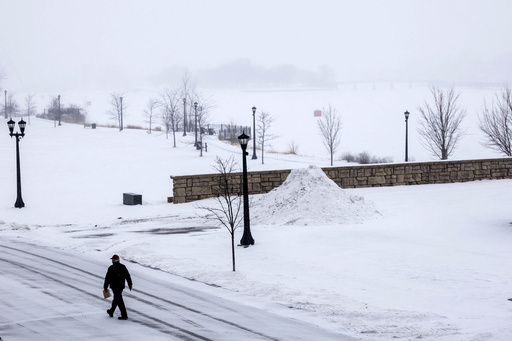Severe storms caused significant snowfall and freezing rain across a vast stretch of the U.S. East, impacting areas from Kentucky to the Washington, D.C. region. This weather system resulted in a wave of traffic incidents, power outages, and potential flooding as temperatures began to rise on Wednesday. Meanwhile, California was on high alert for an atmospheric river that posed a risk of flooding in regions affected by recent wildfires.
The storm, which moved through the eastern United States on Tuesday, left behind over 14 inches (37 centimeters) of snow in Iron Gate, Virginia, and 12 inches in West Virginia’s White Sulphur Springs, as reported by the National Weather Service.
As of Wednesday, more than 190,000 customers in Virginia and nearly 16,000 in North Carolina were without electricity, per data from PowerOutage.us. Appalachian Power, which services West Virginia, Virginia, and Tennessee, indicated that around 5,700 workers were deployed to restore electricity.
Air travel faced disruptions as numerous airports received several inches of snow. Scott Kleebauer, a meteorologist at the Weather Prediction Center, noted the increasing storm activity after a relatively quiet period in previous seasons. Flight delays and cancellations exceeded 7,000 across the nation, with nearly 300 flights affected at Ronald Reagan National Airport in Washington, D.C., according to flight tracking services.
In Virginia, schools were closed for the second consecutive day, and educational districts in the Baltimore and Washington areas also announced that students and faculty would not have classes on Wednesday. Families seized the snowy weather as an opportunity to enjoy outdoor activities such as sledding near the U.S. Capitol.
As temperatures rose, rain was anticipated to replace the snow and ice later in the afternoon, raising concerns about flooding from rainfall and melting snow in previously saturated areas. The National Weather Service highlighted a flood risk extending until Thursday morning from eastern Tennessee through southwestern Virginia and into other southern regions.
Vance Joyner, a meteorologist in Blacksburg, Virginia, expressed worries about the potential flooding due to streams and rivers swelling as a result of melted snow and rain occurring simultaneously.
The adverse weather led to numerous accidents. In Kentucky, a head-on collision resulting in a death occurred due to icy roads. In Virginia, approximately 850 traffic incidents were recorded by state police on Tuesday and Wednesday, with many involving injuries, while Maryland State Police reported 235 automobile accidents.
Notably, another storm system was forecast to bring heavy snow from Oklahoma to the Great Lakes on Wednesday. In parts of Oklahoma, Kansas, and Missouri, government offices observed closures, and some universities canceled classes as a precaution.
In Missouri, an incident involving a GoJet Airlines flight demonstrated the hazards of winter weather; the aircraft slid off an icy taxiway at St. Louis Lambert International Airport but fortunately, there were no injuries reported among those on board.
On the West Coast, officials extended a state of emergency in Multnomah County, Oregon, with six emergency shelters available for residents. Wind chill readings in Portland could plummet to 10 degrees Fahrenheit (-12 degrees Celsius). An ice storm is expected to impact the region just before Valentine’s Day, potentially complicating flower deliveries. Despite the conditions, local florist Julia Duncan remains optimistic, recalling how past winters’ ice storms had not deterred customers from procuring gifts for loved ones.
In California, voluntary evacuation warnings were issued for areas in Orange County previously affected by wildfires. Local authorities prepared for complications due to anticipated rain and recognized the potential dangers of flooding and debris flows linked to the upcoming storm.




